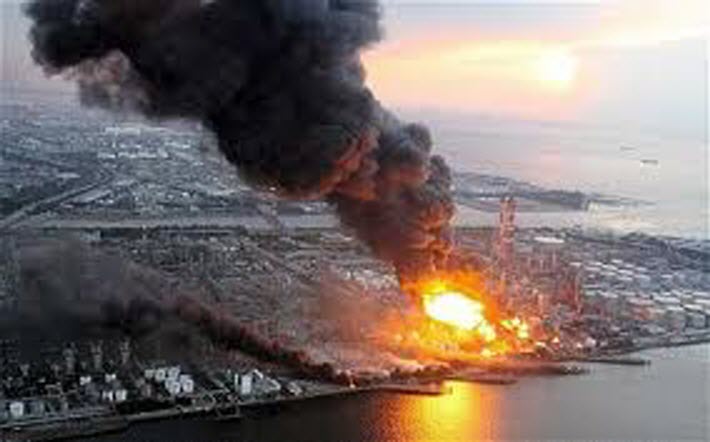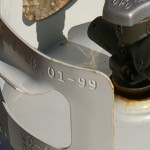
March 11, 2011: A massive earthquake strikes off the coast of Japan. Thousands die in the chaos that ensues after the quake and resultant 33 foot high tsunami that follows. The reactors located at the Fukushima Daiichi nuclear plant sustain significant damage and has been hailed as the worst nuclear accident since Chernobyl in 1986.
March 13, 2011: The NRC states that they do not expect harmful levels of radiation to reach the US: http://pbadupws.nrc.gov/docs/ML1107/ML110720002.pdf
March 15, 2011: MSNBC.com– “Scientists and nuclear experts say they can’t stress enough that no contamination is expected to reach the U.S. and precautions such as stockpiling potassium iodide are not necessary.” According to this article and many others like it, it isn’t necessary for US and North American residents to acquire the radiation tablets. However, one should take note how the US government has handled past precautionary measures. A significant amount of radiation pills were purchased for US troops in 2001 and again for US postal workers in 2002 to prepare for the possibility of dirty bombs being set off in the US or attacks on North American nuclear power plants.
March 16, 2011: Regarding skyrocketing sales of radiation pills…from The Huffington Post the California EMA and the California Department of Public health issue a statement:
We urge Californians to not take potassium iodide as a precautionary measure. It is not necessary given the current circumstances in Japan, it can present a danger to people with allergies to iodine, shellfish or who have thyroid problems, and taken inappropriately it can have serious side effects including abnormal heart rhythms, nausea, vomiting, electrolyte abnormalities and bleeding.
This same article from HuffPo states that “There’s been no indication so far that measurable amounts will reach the U.S. Pacific coast. More than 5,000 miles of open ocean separate Tokyo and Los Angeles, and scientists say there is little current risk of increased radiation even in Japan, outside of a narrow swath of land within a few miles of the damaged plant.”
March 21, 2011: Bloomberg News reported that some radiation monitors in California, Oregon, and Washington State may not be working properly, as abnormal readings are being reported from some of the units. http://www.bloomberg.com/news/2011-03-21/some-radiation-tracking-air-monitors-may-not-be-working-properly-epa-says.html
April, 1, 2011: From NPR.org: Japanese officials forced to admit radiation levels from the damaged nuclear reactors reported were misstated.
On April 28, 2011: here at Radical Survivalism, we reported on food shortages from popular suppliers of long term, freeze dried food as consumers stocked up in case of nuclear disaster in Japan. http://radicalsurvivalism.com/web/2011/04/28/delays-announced-for-emergency-food-supplier/
December 2011: Radiation.org reports increased mortality in the US, citing correlations to the disaster in Japan in March of that year. http://www.radiation.org/reading/pubs/HS42_1F.pdf What is notable regarding this investigation is that this report appeared on MarketWatch.com, but the report seems to have been scrubbed from the Market Watch web site.
January 25, 2012: Popular blog EXSKF relays the chilling comments from city assemblyman Yoshiyuki Motoyama “…share the pain of Tohoku.” Motoyama was apparently displaying his displeasure at parents who wished to have their children dropped from the school lunch program so as to bring food from home. Parents were concerned that food provided in the school lunches may have been exposed to radiation. http://ex-skf.blogspot.com/2012/01/city-assemblyman-in-tokyo-to-school.html
February 3, 2012: Japanese government employees take part in an evacuation drill in Tokyo. According to Military.com, “The exercise gave the U.S. military’s ships a chance to plan for an evacuation under various circumstances, including a situation where mooring at the otherwise intact pier might prove unwise.” http://www.military.com/news/article/army-navy-ships-take-part-in-tokyo-evacuation-drill.html
March 28, 2012: Real Economics-Fukushima is still a big problem.
Question: Is the nuclear power plant safe now?
Yukitero Naka, Nuclear Engineer: Well, that’s what TEPCO and the government says, but the people in there don’t believe it. There is still a great danger. My personal concern is the fourth reactor block.
March 30, 2012: The Guardian reports the 12 mile evacuation perimeter around Fukushima “largely intact” while some towns are being reclassified: http://www.guardian.co.uk/world/2012/mar/30/japan-fukushima-evacuation-zone
In the wake of supply of potassium iodide in the US being depleted by a huge uptick in purchases by consumers after the earthquake in Japan, this next report illustrates our government’s ability to commandeer a huge supply of product at any given time. http://www.wnd.com/2011/04/285721/ Shortly after the disaster at Fukushima, vendors posted on their websites that Rad Stickers were not available for purchase, as all supply had been purchased by the US government to be sent to Japan. A Rad Sticker is small sticker (produced in the US) that can detect radiation exposure and were given to first responders, civilians as well as reporters that were sent to Japan to cover the tragedy.
The story that 40 million are to be evacuated from Japan (according to the EUTimes.com) appears to originate from Sorcha Faal. Is important to note that Sorcha Faal (whatdoesitmean.com) is reported to be an alias of David Booth, a noted conspiracy theorist. http://rationalwiki.org/wiki/Sorcha_Faal
In spite of the dubious origins of this report, it may be of great interest to you, the reader, that there are reports that 9,000 of the 19,000 US troops are to be removed from Okinawa. Japan has pledged 3.1 billion dollars to subsidize a portion of the 8.6 billion cost of the relocation. Some of these troops will be sent to Hawaii, to Guam, or to start a new rotational process in of all places, Australia.
A deal forged by the US in 2006 to move Futenma Air Force Base to date has never been implemented. The failed contract resulted in political suicide on the part of Yukio Hatoyama of Japan in 2009. Hatoyama was unable to fulfill his campaign promises of putting the deal into action and was forced to resign.
From the MarineCorpstimes.com April 27, 2012:
Citing an “increasingly uncertain security environment” in the Asia-Pacific region, they said their agreement was intended to maintain a robust U.S. military presence to ensure the defense of Japan.
Which raises the question, defense from what?
Whispers on the internet suggest that some Japanese could be evacuated to the “Ghost Cities” of China, while other articles suggest that Japan needs to be protected from China’s rise. This conflict of reporting may incite some conspiracists to claim that the quiet movement of troops off of Okinawa is being implemented without fanfare as to avoid global panic.
From Akio Matsumura, regarding the situation at Fukushima…we are told that “The current Japanese government has not yet mentioned the looming disaster, ostensibly to not incite panic in the public. Nevertheless, action must be taken quickly.”
On April 2, 2012, Takao Yamada of The Mainichi writes:
The worse-case scenario drawn up by the government includes not only the collapse of the No. 4 reactor pool, but the disintegration of spent fuel rods from all the plant’s other reactors. If this were to happen, residents in the Tokyo metropolitan area would be forced to evacuate.
April 9, 2012. The L.A. Times informs us that radiation from Japan has been detected in kelp beds off the coast of California. Kelp is present in many food and pharmaceuticals and is commonly referred to as carageenan in ingredients. Giant kelp beds are also home to thousands of species of fish and sea life.
The Japan Times online reveals in an interview September 19, 2011 with the former Japanese Prime Minister Naoto Kan that the president of TEPCO (Tokyo Electric Power Company) wanted to evacuate their staff from the Fukushima facility on March 15, 2011. Prime Minister Kan’s response was he was “outraged.” Kan resigned earlier in the month of September, 2011.
As early as March 15, 2011, following the crisis in Japan, the invitation had been extended from Russia to Japan to receive Japanese nationals. http://www.eutimes.net/2011/03/russias-zhirinovsky-calls-on-japanese-to-move-to-russia/
This week the “Chair of the Japanese Democratic Party’s Political Council Seiji Maehara is set to visit Moscow from April 29 to May 4 to discuss a range of territorial issues with Russia’s Foreign Ministry and the Federal Assembly. Coming ahead of Vladimir Putin’s inauguration as President, this visit can initiate a new round of talks on the disputed sovereignty of the Kuril Islands.” http://english.ruvr.ru/2012_04_13/71656029/
Since the end of World War II, discussions have gone on between Russia and Japan over the Kuril Islands without making any forward progress. Currently, it would appear that the two countries may be attempting to come to an agreement on settling the old grievances generated when Russia seized the islands from Japan during the war. Could the Kuril Islands potentially be a safety net for millions of displaced Japanese citizens?
Meanwhile, back in the States…Prime Minister Yoshihiko Noda of Japan visits with President Obama at the White House 4/29/12 and is to be treated to a gala dinner and Samurai exhibition by Secretary of State Hillary Clinton.
The two following articles are of great interest to those in the online preparedness community. From RT April 4, 2012: DHS Won’t Explain its Order of 450 million Hollow Point Bullets. http://rt.com/usa/news/dhs-million-point-government-179/ And from Fed Biz Opps: https://www.fbo.gov/index?s=opportunity&mode=form&id=19f566deeffa645babd1e3731b7326c6&tab=core&_cview=1 Behind the scenes, once again the US government is purchasing great quantities of radiation pills.
April 16, 2012: Reuters. US Senator Ron Wyden (OR) “…the damage was much worse than he expected.” Senator Wyden, who is a senior senator on the Senate Energy committee, toured the Fukushima Daiichi Nuclear plant on April 6 this month.
April 30, 2012: ENE News-In an anonymous interview April 29, 2012 with a PhD student from Tokyo, we are told that Medical doctors working in Fukushima say lots of people are dying — “Bleeding, losing hair, and having a bad health condition.” http://enenews.com/interview-medical-doctors-working-fukushima-lots-people-dying-bleeding-losing-hair-having-bad-health-condition-video
Today, as of this writing, an “urgent” request has been sent to the UN Secretary General Ban-ki Moon regarding the seriousness of the situation at Fukushima. Green Action Japan states:
We Japanese civil organizations express our deepest concern that our government does not inform its citizens about the extent of risk of the Fukushima Daiichi Unit 4 spent nuclear fuel pool. Given the fact that collapse of this pool could potentially lead to catastrophic consequences with worldwide implications, what the Japanese government should be doing as a responsible member of the international community is to avoid any further disaster by mobilizing all the wisdom and the means available in order to stabilize this spent nuclear fuel. It is clearly evident that Fukushima Daiichi Unit 4 spent nuclear fuel pool is no longer a Japanese issue but an international issue with potentially serious consequences. Therefore, it is imperative for the Japanese government and the international community to work together on this crisis before it becomes too late. We are appealing to the United Nations to help Japan and the planet in order to prevent the irreversible consequences of a catastrophe that could affect generations to come.







